socket buffer结构解析
Table of Contents
socket buffer
当网络包被内核分析时,底层协议的数据被传送更高层.当数据传送时过程反过来.由不同协议产生的数据(包括头和负载)不断往下层传递直到它们最终被发送.因为这些操作的速度对于网络层的表现至关重要,内核使用一个特定的结构叫
socket buffer ,定义如下.Socket buffer被用来在网络实现层交换数据而 不用拷贝来或去数据包 –这显著获得速度收益.
/* include/linux/skbuff.h */ struct sk_buff { /* These two members must be first. */ struct sk_buff *next; struct sk_buff *prev; struct sock *sk; ktime_t tstamp; struct net_device *dev; struct dst_entry *dst; char cb[48]; unsigned int len, data_len; __u16 mac_len, hdr_len; union { __wsum csum; struct { __u16 csum_start; __u16 csum_offset; }; }; __u32 priority; __u8 local_df:1, cloned:1, ip_summed:2, nohdr:1, nfctinfo:3; __u8 pkt_type:3, fclone:2, ipvs_property:1; nf_trace:1; __be16 protocol; ... void (*destructor)(struct sk_buff *skb); ... int iif; ... sk_buff_data_t transport_header; sk_buff_data_t network_header; sk_buff_data_t mac_header; /* These elements must be at the end, see alloc_skb() for details. */ sk_buff_data_t tail; sk_buff_data_t end; unsigned char *head, *data; unsigned int truesize; atomic_t users; };
Using Socket Buffers
Socket buffers 由许多指针链接而成,如下图.图中假设32位系统,在64位机器上
socket buffer的结构稍微有点不同.
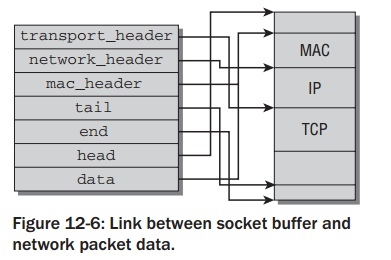
socket buffer的基本理念是通过操作不同的指针来添加或取出协议的头部.
- head和end指向数据缓存区域的start和end.
- data和tail指向实际协议数据区域的start和end.
mac_header指向MAC头的start,network_header和transport_header分别指向network和transport层的数据头.在32位的系统中,用来定义上面变量的数据类型sk_buff_data_t仅仅是一个简单的指针://<skbuff.h> typedef unsigned char *sk_buff_data_t;
使得kernel对于不同的协议类型都能使用socket buffer.简单的类型转换对于正确解析数据是必要的.比如一个socket buffer包含TCP包,TCP头如何从这个 socket buffer获得:
//<tcp.h> static inline struct tcphdr *tcp_hdr(const struct sk_buff *skb) { return (struct tcphdr *)skb_transport_header(skb); }
其他类似的转换的函数以
xxx_hdr形式.
因为对于网络层来说,低内存占用和高处理速度是必要的,所以对于 struct
sk_buff 来说,希望这个结构尽可能的小.在64位系统中,使用小技巧来节省一些空间. sk_buff_data_t 定义变成一个整型变量:
//<skbuff.h> typedef unsigned int sk_buff_data_t;
因为整型只需要指针内存的一半(4取代8字节)在一些系统架构上,那么这个结构节省20字节.data和head仍然是普通指针,其他 sk_buff_data_t 元素现在被解析成相对这些指针的偏移量.指向transport头的起始指针现在如下计算:
static inline unsigned char *skb_transport_header(const struct sk_buff *skb) { return skb->head + skb->transport_header; }
用这个方法是可行的,因为4字节足够表示4G的内存空间,而一个socket buffer永远不会超过这个大小.
data和tail使得数据在不同协议层间传递不用显示的拷贝操作,如下图.显示包如何处理.
当一个新包产生,TCP 层先在用户空间分配内存来存储包的数据(包括头和负载).比数据更多的足够的空间被预留使得底层能加入更多的头部数据.head和end指向预留空间的start和end,而TCP 数据在data和tail之间.
当socket buffer传递到IP 层,新的协议头要加入其中,其他指针不变,除了data 现在指向IP 头的起始处.同样的操作被之后的下层协议重复,直到完成的包被发送往网络.
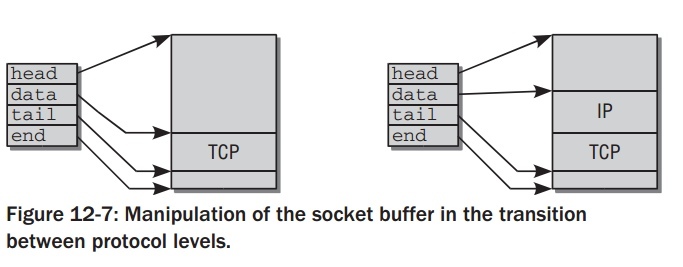
Operations on socket buffers
看 include/linux/skbuff.h 中ocket buffer的一些常用的操作:
- allocate
sk_buffsk_buff有两部分组成:sk_buff(skb_buff本身描述符 和 其中data内从空间) 和skb_share_info.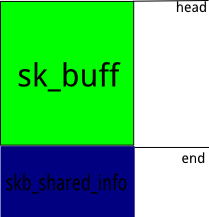
alloc_skb调用了一个内部函数__alloc_skb(详见__alloc_skb). 并且:- fclone=0 : 不从fclone cache分配skb的头, 从head cache中.
- node=-1: NUMA不使用.
分配过程主要分为:
- 从cache中分配skb的本身描述符.
- 优化对cache的对齐,对数据大小做algin操作:
size = SKB_DATA_ALIGN(size);. - 分配data内存,包括size和
skb_shared_info大小:data = kmalloc_node_track_caller(size + sizeof(struct skb_shared_info), gfp_mask, node); - 对skb字段做一些初始化,其中
skb->truesize = size + sizeof(struct sk_buff);是总的大小. - 最后对
skb_shared_info做一些初始化.
static inline struct sk_buff *alloc_skb(unsigned int size, gfp_t priority) { return __alloc_skb(size, priority, 0, -1); } // example struct sk_buff *skbn; if ((skbn = alloc_skb(len, GFP_ATOMIC)) == NULL) return;
- free
sk_buffvoid kfree_skb(struct sk_buff *skb) { if (unlikely(!skb)) return; if (likely(atomic_read(&skb->users) == 1)) smp_rmb(); else if (likely(!atomic_dec_and_test(&skb->users))) return; __kfree_skb(skb); }
稍微分析一下:
- 若skb是NULL,直接返回.
- 如果
skb->users = 1, 那么说明没有其他代码在使用它,需要free,smp_rmb();是一个memory barrier, 防止内存乱序执行,防止的是多线程释放的情况,更多内容见浅谈Memory Reordering. atomic_dec_and_test(&skb->users)减1后再次判断引用是否为0,上面已经判断不是1了,这里是否必要再次判断?是需要的,if和else if间不是原子操作,其他进程在这之间可以插入free这个skb.所以原子减后需要再次判断是否能free.
在
__kfree_skb(skb);中release data时会判断!skb->cloned不是clone 的才会释放data空间. - copy of
sk_buffstruct sk_buff *skb_copy(const struct sk_buff *skb, gfp_t gfp_mask) { int headerlen = skb->data - skb->head; /* * Allocate the copy buffer */ struct sk_buff *n; #ifdef NET_SKBUFF_DATA_USES_OFFSET n = alloc_skb(skb->end + skb->data_len, gfp_mask); #else n = alloc_skb(skb->end - skb->head + skb->data_len, gfp_mask); #endif if (!n) return NULL; /* Set the data pointer */ skb_reserve(n, headerlen); /* Set the tail pointer and length */ skb_put(n, skb->len); if (skb_copy_bits(skb, -headerlen, n->head, headerlen + skb->len)) BUG(); copy_skb_header(n, skb); return n; }
拷贝整个
skb_buff结构,包括描述符和数据缓存区.//example struct sk_buff *skbn = skb_copy(skb, GFP_ATOMIC);
- clone of
sk_buffstruct sk_buff *skb_clone(struct sk_buff *skb, gfp_t gfp_mask) { struct sk_buff *n; n = skb + 1; if (skb->fclone == SKB_FCLONE_ORIG && n->fclone == SKB_FCLONE_UNAVAILABLE) { atomic_t *fclone_ref = (atomic_t *) (n + 1); n->fclone = SKB_FCLONE_CLONE; atomic_inc(fclone_ref); } else { n = kmem_cache_alloc(skbuff_head_cache, gfp_mask); if (!n) return NULL; n->fclone = SKB_FCLONE_UNAVAILABLE; } return __skb_clone(n, skb); }
clone和copy不一样,只生成新的
sk_buff的描述符结构,数据缓存区直接指向旧的,基本步骤:- 分配新的
sk_buff结构体. - 拷贝结构体内容.
atomic_set(&n->users, 1);:has a reference count of 1.skb->cloned = 1;:设置clone位.
- 分配新的
skb_putstatic inline unsigned char *skb_put(struct sk_buff *skb, unsigned int len) { unsigned char *tmp = skb_tail_pointer(skb); SKB_LINEAR_ASSERT(skb); skb->tail += len; skb->len += len; if (unlikely(skb->tail > skb->end)) skb_over_panic(skb, len, current_text_addr()); return tmp; }
扩展被使用的data区域.并返回准备存储data的起始位置的指针. example: 从ipbuf中拷贝16字节到 skb 中 data 的末尾处.
//example memcpy(skb_put(skb,16),ipbuf,16);
skb_tailroomandskb_headroom/** * skb_tailroom - bytes at buffer end */ static inline int skb_tailroom(const struct sk_buff *skb) { return skb_is_nonlinear(skb) ? 0 : skb->end - skb->tail; } static inline int skb_is_nonlinear(const struct sk_buff *skb) { return skb->data_len; } /** * skb_headroom - bytes at buffer head */ static inline unsigned int skb_headroom(const struct sk_buff *skb) { return skb->data - skb->head; }
skb_headroom返回data缓存区前部分的空闲大小.skb_tailroom而返回data缓存区后部分空闲大小.
skb->data_len是分片内存中数据长度,通过它来判断skb的数据缓存区是否线程,不是线性,skb 尾部空的内存大小为0, 若线性的, 尾部空的内存空间是skb->end - skb->tail.example: 把skb的data扩展到区域大小扩展到
min_frame_size.int min_frame_size = 62; if (skb->len < min_frame_size) { if ((skb->len + skb_tailroom(skb)) < min_frame_size) { skb2 = skb_copy_expand(skb, 0, min_frame_size - skb->truesize, GFP_ATOMIC); dev_kfree_skb(skb); if (skb2 == NULL) { priv->stats.tx_dropped++; return 0; } skb = skb2; } skb_put(skb, min_frame_size - skb->len); }
skb_realloc_headroom当skb的headroom大小不够时,可以用这个函数扩展其大小.它完成了两个功能:
- 扩展headroom.
- 创建新的skb结构,并复制之前的skb和部分它的数据.
- 返回的skb的reference count是1.
//example if (skb_headroom(skb) < len) { if ((skbn = skb_realloc_headroom(skb, len)) == NULL) { printk(KERN_CRIT "out of memory\n"); return NULL; } if (skb->sk != NULL) skb_set_owner_w(skbn, skb->sk); kfree_skb(skb); skb = skbn; }
skb_reservestatic inline void skb_reserve(struct sk_buff *skb, int len) { skb->data += len; skb->tail += len; }
- 通过减少tail的空间来增加headroom的大小.
- 它只允许对空buffer操作.
- transport/network/mac operation
sk_buff中有3个头结构的域:transport_header,network_header和mac_header.对于它们的操作类似,主要有:
skb_xx_header: 获取相应头的起始处.skb_reset_xx_header: 重新赋值为skb->data.skb_set_xx_header: 设置为skb->data + offset;.
Management Data of Socket Buffers
socket buffer结构体中主要被使用的元素:
dev
类型是 net_device , net_device 它代表一个网络设备。dev的作用与这个包是准备发出的包还是刚接收的包有关.当收到一个包时,设备驱动会把 sk_buff 的dev指针指向收到这个包的网络设备;当一个包被发送时,这个变量代表将要发送这个包的设备.
tstamp
存储包到达的时间.
sk
sk是将处理包的socket实例的指针.
dst
通过network实现层时,指示包如何route.使用这一特殊的结构 struct
dst_entry .
next 和 prev
next 和 prev 使得socket buffer链接在一个双向链表中.kernel标准的
list 实现并没有在这里使用,取而代之的是手动的版本. list头被用来实现
socket buffers的等待队列,它的结构如下:
struct sk_buff_head { /* These two members must be first. */ struct sk_buff *next; struct sk_buff *prev; __u32 qlen; spinlock_t lock; };
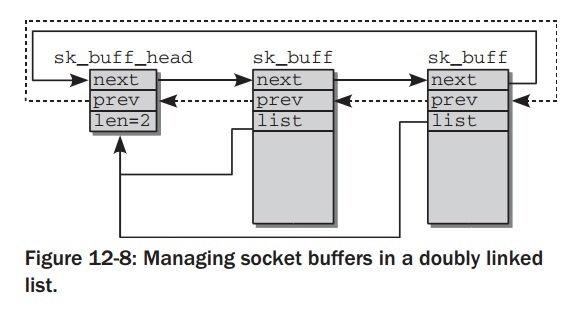
cloned
当被设置时,表示这个结构是另一个skbuff的克隆.
len, data_len 和 truesize
len: 当前协议数据包的长度.包括data中的缓冲数据和分片中的数据.data_len: 只包含分片中数据.truesize: 整个data的长度和sk_buff描述符的长度.
head, data, tail, end
head和end指向缓冲区的头部和尾部,而data和 tail指向实际数据的头部和尾部。
transport_header, network_header, 和 mac_header
这些是指向TCP/IP 各层协议头的指针:th指向L4(传输层),nh指向L3(网络层), mach指向L2(数据链路层)。
cb[48]
它是一个 control buffer. 在每一层,它都可以自由使用,所以把私有控制变量放在这个缓存空间.如果想在层与层之间使用,必须先做 skb_clone() .一般访问这个变量使用宏来实现以增强代码的可读性。比如TCP使用这个变量存储
tcp_skb_cb 结构。
#define TCP_SKB_CB(__skb) ((struct tcp_skb_cb *)&((__skb)->cb[0]))
使用实例:
// net/ipv4/tcp_output.c TCP_SKB_CB(buff)->seq = TCP_SKB_CB(skb)->seq + len; TCP_SKB_CB(buff)->end_seq = TCP_SKB_CB(skb)->end_seq; TCP_SKB_CB(skb)->end_seq = TCP_SKB_CB(buff)->seq;
pkt_type
这个变量表示帧的类型,分类是由L2的目的地址来决定的。这个值在网卡驱动程序中由函数 eth_type_trans 通过判断目的以太网地址来确定。
- 如果目的地址是FF:FF:FF:FF:FF:FF,则为广播地址,
pkt_type = PACKET_BROADCAST; - 如果最高位为1,则为组播地址.
pkt_type = PACKET_MULTICAST; - 如果目的mac地址跟本机mac地址不相等,则不是发给本机的数据报,
pkt_type = PACKET_OTHERHOST; - 否则就是缺省值
PACKET_HOST。
// include/linux/if_packet.h /* Packet types */ #define PACKET_HOST 0 /* To us */ #define PACKET_BROADCAST 1 /* To all */ #define PACKET_MULTICAST 2 /* To group */ #define PACKET_OTHERHOST 3 /* To someone else */ #define PACKET_OUTGOING 4 /* Outgoing of any type */
protocol
这个变量是高层协议从二层设备的角度所看到的协议。典型的协议包括IP,IPV6
和ARP。完整的列表在 include/linux/if_ether.h 中。由于每个协议都有自己的协议处理函数来处理接收到的包,因此,这个域被设备驱动用于通知上层调用哪个协议处理函数。详细见 netif_receive_skb 函数中,比对socket buffer的
protocol,传递到相应的协议处理函数中去.
Details of how SKB work1
the layout of the SKB data area
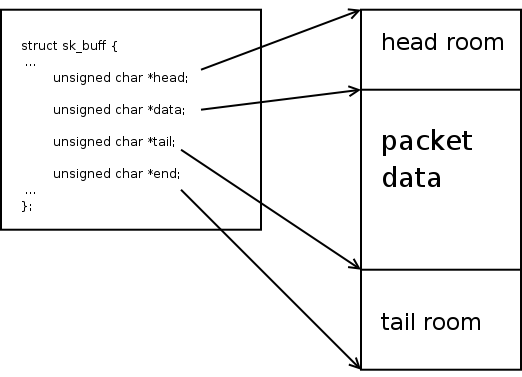
This first diagram illustrates the layout of the SKB data area and
where in that area the various pointers in struct sk_buff point.
alloc_skb
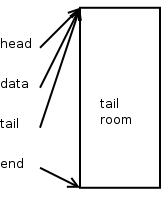
skb = alloc_skb(len, GFP_KERNEL);
This is what a new SKB looks like right after you allocate it using
alloc_skb().
As you can see, the head, data, and tail pointers all point to the beginning of the data buffer. And the end pointer points to the end of it. Note that all of the data area is considered tail room.
The length of this SKB is zero, it isn't very interesting since it
doesn't contain any packet data at all. Let's reserve some space for
protocol headers using skb_reserve().
skb_reserve
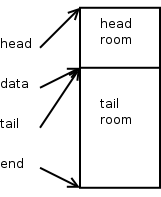
skb_reserve(skb, header_len);
This is what a new SKB looks like right after the skb_reserve() call.
Typically, when building output packets, we reserve enough bytes for
the maximum amount of header space we think we'll need. Most IPV4
protocols can do this by using the socket value
sk->sk_prot->max_header.
When setting up receive packets that an ethernet device will DMA into,
we typically call skbreserve(skb, NET_IP_ALIGN). By default
NET_IP_ALIGN is defined to '2'. This makes it so that, after the
ethernet header, the protocol header will be aligned on at least a
4-byte boundary. Nearly all of the IPV4 and IPV6 protocol processing
assumes that the headers are properly aligned.
Let's now add some user data to the packet.
skb_put
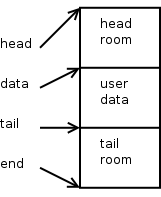
unsigned char *data = skb_put(skb, user_data_len); int err = 0; skb->csum = csum_and_copy_from_user(user_pointer, data, user_data_len, 0, &err); if (err) goto user_fault;
This is what a new SKB looks like right after the user data is added.
skb_put() advances skb->tail by the specified number of bytes, it
also increments skb->len by that number of bytes as well. This
routine must not be called on a SKB that has any paged data. You must
also be sure that there is enough tail room in the SKB for the amount
of bytes you are trying to put. Both of these conditions are checked
for by skb_put() and an assertion failure will trigger if either rule
is violated.
The computed checksum is remembered in skb->csum. Now, it's time to
build the protocol headers. We'll build a UDP header, then one for
IPV4.
push the UDP header to the front of the SKB
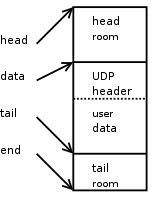
struct inet_sock *inet = inet_sk(sk); struct flowi *fl = &inet->cork.fl; struct udphdr *uh; skb->h.raw = skb_push(skb, sizeof(struct udphdr)); uh = skb->h.uh uh->source = fl->fl_ip_sport; uh->dest = fl->fl_ip_dport; uh->len = htons(user_data_len); uh->check = 0; skb->csum = csum_partial((char *)uh, sizeof(struct udphdr), skb->csum); uh->check = csum_tcpudp_magic(fl->fl4_src, fl->fl4_dst, user_data_len, IPPROTO_UDP, skb->csum); if (uh->check == 0) uh->check = -1;
This is what a new SKB looks like after we push the UDP header to the front of the SKB.
skb_push() will decrement the skb->data pointer by the specified
number of bytes. It will also increment skb->len by that number of
bytes as well. The caller must make sure there is enough head room for
the push being performed. This condition is checked for by skb_push()
and an assertion failure will trigger if this rule is violated.
Now, it's time to tack on an IPV4 header.
push the IPv4 header to the front of the SKB
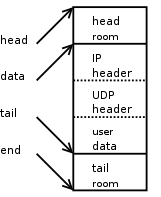
struct rtable *rt = inet->cork.rt; struct iphdr *iph; skb->nh.raw = skb_push(skb, sizeof(struct iphdr)); iph = skb->nh.iph; iph->version = 4; iph->ihl = 5; iph->tos = inet->tos; iph->tot_len = htons(skb->len); iph->frag_off = 0; iph->id = htons(inet->id++); iph->ttl = ip_select_ttl(inet, &rt->u.dst); iph->protocol = sk->sk_protocol; /* IPPROTO_UDP in this case */ iph->saddr = rt->rt_src; iph->daddr = rt->rt_dst; ip_send_check(iph); skb->priority = sk->sk_priority; skb->dst = dst_clone(&rt->u.dst);
This is what a new SKB looks like after we push the IPv4 header to the front of the SKB.
Just as above for UDP, skb_push() decrements skb->data and
increments skb->len. We update the skb->nh.raw pointer to the
beginning of the new space, and build the IPv4 header.
This packet is basically ready to be pushed out to the device once we have the necessary information to build the ethernet header (from the generic neighbour layer and ARP).
paged data
Things start to get a little bit more complicated once paged data
begins to be used. For the most part the ability to use [page,
offset, len] tuples for SKB data came about so that file system file contents
could be directly sent over a socket. But, as it turns out, it is
sometimes beneficial to use this for normal buffering of process
sendmsg() data.
It must be understood that once paged data starts to be used on an
SKB, this puts a specific restriction on all future SKB data area
operations. In particular, it is no longer possible to do skb_put()
operations.
We will now mention that there are actually two length variables
assosciated with an SKB, len and data_len. The latter only comes into
play when there is paged data in the SKB. skb->data_len tells how
many bytes of paged data there are in the SKB. From this we can derive a
few more things:
- The existence of paged data in an SKB is indicated by
skb->data_lenbeing non-zero. This is codified in the helper routineskb_is_nonlinear()so that it the function you should use to test this. - The amount of non-paged data at
skb->datacan be calculated asskb->len - skb->data_len. Again, there is a helper routine already defined for this calledskb_headlen()so please use that.
The main abstraction is that, when there is paged data, the packet
begins at skb->data for skb_headlen(skb) bytes, then continues on into
the paged data area for skb->data_len bytes. That is why it is
illogical to try and do an skb_put(skb) when there is paged data. You
have to add data onto the end of the paged data area instead.
Each chunk of paged data in an SKB is described by the following structure:
struct skb_frag_struct { struct page *page; __u16 page_offset; __u16 size; };
There is a pointer to the page (which you must hold a proper reference to), the offset within the page where this chunk of paged data starts, and how many bytes are there.
The paged frags are organized into an array in the shared SKB area, defined by this structure:
#define MAX_SKB_FRAGS (65536/PAGE_SIZE + 2) struct skb_shared_info { atomic_t dataref; unsigned int nr_frags; unsigned short tso_size; unsigned short tso_segs; struct sk_buff *frag_list; skb_frag_t frags[MAX_SKB_FRAGS]; };
The nr_frags member states how many frags there are active in the
frags[] array. The tso_size and tso_segs is used to convey information
to the device driver for TCP segmentation offload. The frag_list is
used to maintain a chain of SKBs organized for fragmentation purposes,
it is not used for maintaining paged data. And finally the frags[]
holds the frag descriptors themselves.
A helper routine is available to help you fill in page descriptors.
void skb_fill_page_desc(struct sk_buff *skb, int i, struct page *page, int off, int size)
This fills the i'th page vector to point to page at offset off of size
size. It also updates the nr_frags member to be one past i.
If you wish to simply extend an existing frag entry by some number of
bytes, increment the size member by that amount.
two helper routines
With all of the complications imposed by non-linear SKBs, it may seem difficult to inspect areas of a packet in a straightforward way, or to copy data out from a packet into another buffer. This is not the case. There are two helper routines available which make this pretty easy.
First, we have:
void *skb_header_pointer(const struct sk_buff *skb, int offset, int len, void *buffer)
You give it the SKB, the offset (in bytes) to the piece of data you are interested in, the number of bytes you want, and a local buffer which is to be used only if the data you are interested in resides in the non-linear data area.
You are returned a pointer to the data item, or NULL if you asked for
an invalid offset and len parameter. This pointer could be one of two
things. First, if what you asked for is directly in the skb->data
linear data area, you are given a direct pointer into there. Else, you
are given the buffer pointer you passed in.
Code inspecting packet headers on the output path, especially, should use this routine to read and interpret protocol headers. The netfilter layer uses this function heavily.
For larger pieces of data other than protocol headers, it may be more appropriate to use the following helper routine instead.
int skb_copy_bits(const struct sk_buff *skb, int offset, void *to, int len);
This will copy the specified number of bytes, and the specified
offset, of the given SKB into the to buffer. This is used for copies
of SKB data into kernel buffers, and therefore it is not to be used
for copying SKB data into userspace. There is another helper routine
for that:
int skb_copy_datagram_iovec(const struct sk_buff *from, int offset, struct iovec *to, int size);
Here, the user's data area is described by the given IOVEC. The other
parameters are nearly identical to those passed in to skb_copy_bits()
above.
reference
__alloc_skb
/** * __alloc_skb - allocate a network buffer * @size: size to allocate * @gfp_mask: allocation mask * @fclone: allocate from fclone cache instead of head cache * and allocate a cloned (child) skb * @node: numa node to allocate memory on */ struct sk_buff *__alloc_skb(unsigned int size, gfp_t gfp_mask, int fclone, int node) { struct kmem_cache *cache; struct skb_shared_info *shinfo; struct sk_buff *skb; u8 *data; cache = fclone ? skbuff_fclone_cache : skbuff_head_cache; /* Get the HEAD */ skb = kmem_cache_alloc_node(cache, gfp_mask & ~__GFP_DMA, node); if (!skb) goto out; size = SKB_DATA_ALIGN(size); data = kmalloc_node_track_caller(size + sizeof(struct skb_shared_info), gfp_mask, node); if (!data) goto nodata; /* * See comment in sk_buff definition, just before the 'tail' member */ memset(skb, 0, offsetof(struct sk_buff, tail)); skb->truesize = size + sizeof(struct sk_buff); atomic_set(&skb->users, 1); skb->head = data; skb->data = data; skb_reset_tail_pointer(skb); skb->end = skb->tail + size; /* make sure we initialize shinfo sequentially */ shinfo = skb_shinfo(skb); atomic_set(&shinfo->dataref, 1); shinfo->nr_frags = 0; shinfo->gso_size = 0; shinfo->gso_segs = 0; shinfo->gso_type = 0; shinfo->ip6_frag_id = 0; shinfo->frag_list = NULL; if (fclone) { struct sk_buff *child = skb + 1; atomic_t *fclone_ref = (atomic_t *) (child + 1); skb->fclone = SKB_FCLONE_ORIG; atomic_set(fclone_ref, 1); child->fclone = SKB_FCLONE_UNAVAILABLE; } out: return skb; nodata: kmem_cache_free(cache, skb); skb = NULL; goto out; }
__kfree_skb
void __kfree_skb(struct sk_buff *skb) { skb_release_all(skb); kfree_skbmem(skb); } static void skb_release_all(struct sk_buff *skb) { dst_release(skb->dst); #ifdef CONFIG_XFRM secpath_put(skb->sp); #endif if (skb->destructor) { WARN_ON(in_irq()); skb->destructor(skb); } #if defined(CONFIG_NF_CONNTRACK) || defined(CONFIG_NF_CONNTRACK_MODULE) nf_conntrack_put(skb->nfct); nf_conntrack_put_reasm(skb->nfct_reasm); #endif #ifdef CONFIG_BRIDGE_NETFILTER nf_bridge_put(skb->nf_bridge); #endif /* XXX: IS this still necessary? - JHS */ #ifdef CONFIG_NET_SCHED skb->tc_index = 0; #ifdef CONFIG_NET_CLS_ACT skb->tc_verd = 0; #endif #endif skb_release_data(skb); } static void skb_release_data(struct sk_buff *skb) { if (!skb->cloned || !atomic_sub_return(skb->nohdr ? (1 << SKB_DATAREF_SHIFT) + 1 : 1, &skb_shinfo(skb)->dataref)) { if (skb_shinfo(skb)->nr_frags) { int i; for (i = 0; i < skb_shinfo(skb)->nr_frags; i++) put_page(skb_shinfo(skb)->frags[i].page); } if (skb_shinfo(skb)->frag_list) skb_drop_fraglist(skb); kfree(skb->head); } }
skb_realloc_headroom
struct sk_buff *skb_realloc_headroom(struct sk_buff *skb, unsigned int headroom) { struct sk_buff *skb2; int delta = headroom - skb_headroom(skb); if (delta <= 0) skb2 = pskb_copy(skb, GFP_ATOMIC); else { skb2 = skb_clone(skb, GFP_ATOMIC); if (skb2 && pskb_expand_head(skb2, SKB_DATA_ALIGN(delta), 0, GFP_ATOMIC)) { kfree_skb(skb2); skb2 = NULL; } } return skb2; }
transport/network/mac
/* not NET_SKBUFF_DATA_USES_OFFSET */ static inline unsigned char *skb_transport_header(const struct sk_buff *skb) { return skb->transport_header; } static inline void skb_reset_transport_header(struct sk_buff *skb) { skb->transport_header = skb->data; } static inline void skb_set_transport_header(struct sk_buff *skb, const int offset) { skb->transport_header = skb->data + offset; } static inline unsigned char *skb_network_header(const struct sk_buff *skb) { return skb->network_header; } static inline void skb_reset_network_header(struct sk_buff *skb) { skb->network_header = skb->data; } static inline void skb_set_network_header(struct sk_buff *skb, const int offset) { skb->network_header = skb->data + offset; } static inline unsigned char *skb_mac_header(const struct sk_buff *skb) { return skb->mac_header; } static inline int skb_mac_header_was_set(const struct sk_buff *skb) { return skb->mac_header != NULL; } static inline void skb_reset_mac_header(struct sk_buff *skb) { skb->mac_header = skb->data; } static inline void skb_set_mac_header(struct sk_buff *skb, const int offset) { skb->mac_header = skb->data + offset; }